

... Larry Kaplan
By Scott Stilphen

DP: What’s your educational background?
Larry Kaplan: I attended UC Berkeley from 1968 to 1974 during the Vietnam War era: peace marches, People’s Park, Kent State, Hippies, Drugs and Rock ‘n Roll. I got my BA in Computer Science in 1974.
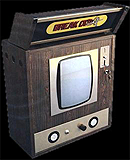 DP:
What inspired you
to go into game design?
DP:
What inspired you
to go into game design?
Larry Kaplan: Well, it certainly wasn’t called game design!! We were just programmers on a job, only we were doing games. It just so happens we had to program, do the art, make the sounds and music, do the game play, and get the hardware to do things it wasn’t designed to do. So, really the question was why did I join Atari? Because I did enjoy playing games and wanted to program them.
DP: Were there any programmers or games that inspired you?
Larry Kaplan: Definitely Atari games at the time were inspiring, especially Breakout for me. I joined Atari so I could play Breakout for free. The games I liked were Sprint and Tank.
DP: Did you work for anyone prior to Atari (after school)?
Larry Kaplan: I worked for Control Systems Industries for two years before joining Atari. The main project I worked on there was a computerized power grid for the Missouri River for the Bureau of Reclamation in Missoula, Montana. A large computer ran a wall of TV screens showing the power grid and the power on each line. Operators could see problems and, from Missoula, throw breakers that were hundreds of miles away. I programmed the microcode that ran in the remote stations that read power line voltages and controlled breakers and sent the info back to Missoula. Then I worked on the integration and took over programming the mainframe to get it all working.
DP: How did you hear about Atari? When did you start working there?
Larry Kaplan: I saw their ad in the Mercury News and applied for the job. I was among 100 applicants and Bob Brown later told me they hired me because I had purchased an Altair 8800 (the first home computer kit). I started in August of 1976.
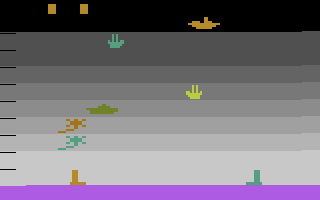
DP: Air-Sea Battle was one of the original 9 games released for the VCS. What was the development process like, in the beginning?
Larry Kaplan: Air-Sea Battle was based on an Atari coin-op called Anti-Aircraft. In those days, we just ripped off anything we could make work. The development process was a nightmare in the beginning. We had a time share service we reached via a teletype to do our editing and assembling. Then we downloaded to a development kit that had only a display and some address switches. Extremely primitive and difficult to use, it made game programming even more difficult.
DP: Most of the early Atari sports titles were… forgettable, but your Bowling game is an exception. The sounds effects really make the game. What do you recall from working on it?
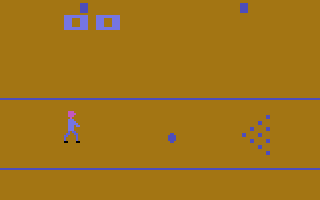 Larry Kaplan:
Unfortunately, I don’t recall much specifically. I was trying to get the physics
correct. Sounds were whatever we could fit in the smallest number of bytes, and
I think I used simple up and down scales for most of the sounds, with slightly
different frequencies. Since we were based on frames, you needed to do something
every nth frame (every frame, every other, etc.) and that meant sounds were
based on a 60 frame rate change. So, if you incremented the sound value each
frame, you would get that upward sound, etc.
Larry Kaplan:
Unfortunately, I don’t recall much specifically. I was trying to get the physics
correct. Sounds were whatever we could fit in the smallest number of bytes, and
I think I used simple up and down scales for most of the sounds, with slightly
different frequencies. Since we were based on frames, you needed to do something
every nth frame (every frame, every other, etc.) and that meant sounds were
based on a 60 frame rate change. So, if you incremented the sound value each
frame, you would get that upward sound, etc.
DP: After Bowling, you worked on the Atari 400/800 Operating System (with David Crane and Alan Miller), correct? What was that project like?
Larry Kaplan:
Yes, that
is correct. It was a nightmare project. Another group of internal programmers
were hired
to do games, but since they weren’t working on one, they were free to work on
the OS. They purchased expensive development systems and spent a year not writing an operating system, so Al,
Dave, and myself were recruited to
deliver an operating system, BASIC, and a couple of titles in 8 weeks.
Starting in late October of
1978, we
designed, wrote, debugged,
and delivered a prototype system with games to be unveiled at the Personal
Computer Conference in San Francisco in January 1979.
development systems and spent a year not writing an operating system, so Al,
Dave, and myself were recruited to
deliver an operating system, BASIC, and a couple of titles in 8 weeks.
Starting in late October of
1978, we
designed, wrote, debugged,
and delivered a prototype system with games to be unveiled at the Personal
Computer Conference in San Francisco in January 1979.
We did hire a consulting company to do BASIC after I told Bill Gates we wouldn’t be using his Microsoft BASIC (I didn’t like that he had run it through a program that converted the original 8080 code to 6502 code since it didn’t always do the best job). Another missed opportunity.
DP: Were you working on any other game(s) at the time you decided to leave Atari?

Larry Kaplan: No, I had wrapped up the 800 OS and my titles for the 800 (Video Easel and Super Breakout) and was recruited to go on the road and sell computers to Sears. But I told the truth too often and left in August of 1979.
DP: Much has been written about Activision’s founding (leaving for lack of fair compensation and credit). How confident were you and the others (Bob Whitehead, Alan Miller, and David Crane) that Activision would (or could) succeed, especially in light of Atari’s lawsuit? If it hadn’t, would you all have gone back to Atari (i.e. did you have a “plan B”)?
Larry Kaplan: Well, there was no plan B. And the lawsuit was timed perfectly. It was front page news at the January 1980 CES in Las Vegas and catapulted the unknown Activision to a big player and our sales skyrocketed and we never looked back.

DP: Bridge features one of the nicest card sets ever shown on the VCS. Are you (or were you) a competitive Bridge player?
Larry Kaplan: Well, thanks. I am sure Dave did those, too :)
I was a duplicate bridge player for a few years (1968-1972 and 1974-1976) and even attended some tournaments. I think I had 1 life point. I wasn’t very good. I couldn’t erase the memory of the bidding and cards of the previous hand before the next one started, so I was always slightly confused (I have the same problem playing the solitaire card game Simple Simon or any changing memory task).
DP: Apparently there are two ROM variations of this game. The original contained a bug in that it allowed m you to bid 8-spades (and crashed when you did); the other corrects this bug. I’ve been searching in vain for a copy of the original for years. Can you confirm the original version was actually released?
Larry Kaplan: Yes, the original was released with a bug and we made quite a few (thousands?) before someone caught the error. But, Bridge was not a super successful title so the number of carts made was relatively small, making them hard to find. Ebay has them for sale occasionally, but I don’t know if there is a way to tell the difference on the outside (unless the copyright dates are different).
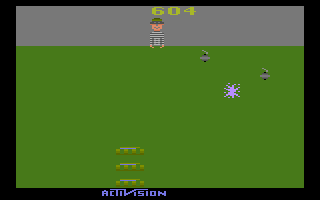

Right: Activision's Kaboom. Left: Atari's Avalanche.
DP: Kaboom is a far-superior game than its predecessor, Atari’s Avalanche coin-op. It’s amazing what a few changes can do to a lack-luster game! Even today it continues to be on most everyone’s “top 10” list of one of the best VCS games ever done. Can you recount the story of how it was developed?
Larry Kaplan: Haha! I wish! Basically, I just ripped off Avalanche, but I had to fit it into 2048 bytes and limited to VCS graphics. So, unable to display a bunch of rocks on top, I changed it to a single figure dropping bombs. David Crane came up with the Mad Bomber and the buckets (both of which he designed for me). Part of the appeal is the leveling process which, again, relies on the 60 frame rate to calculate drop speeds, etc. And it just so happens that those speeds are the most comfortable to play for long stretches.
DP: Although doing sequels was usually the exception back then (unlike now), was there ever a thought do doing a follow-up to it?
Larry Kaplan: No.
DP: Were you involved at all with the Atari 400/800/5200 version (by Paul Wilson)? And why didn’t Activision port it to more systems?
Larry Kaplan: No I wasn’t involved. I had left Activision by then, so whatever they did I had nothing to do with, since I was just an employee with stock options (no royalties or anything tied to games).
DP: When did you leave Activision (and why)?
Larry Kaplan: I left in June of 1982, a week before the company trip to Hawaii. The main reason I left was to start a game hardware company, Hi Toro, to build a replacement for the VCS, since no one had done anything comparable. I had hooked up with Jay Miner and Doug Neubauer and an investor involved with Jay Miner’s company.
DP: Next Generation did a retrospective article about Activision recently (http://tinyurl.com/zz52x) that mentions conditions at Activision were (at the time of you leaving) at the point where phone calls were being monitored. I know Jim Huether once stated that people’s offices at Atari were routinely ‘bugged’ by security, but I wasn’t aware this was happening at Activision as well.
Larry Kaplan: The “monitoring” was really call screening. The other developers didn’t want John Q. Public or Tommy Smith to call and get through. So, we were supposed to turn in a list of people we would accept calls from. I left shortly after that.
DP: I know you went back to Atari at some point, as VP of the VCS software group. What was that like, and how long were you there?
Larry Kaplan: Well, the hardware company started without me (it became Amiga), so I was looking for a job and contacted Ray Kassar, the president of Atari, to find out whether he would invest in new game hardware. He said sure, just as long as I managed the programmers. So, I became VP. It was both up and down. At the E.T. unveiling, the reporters thought I was Steven Spielberg and wanted to interview me. I had executive privilege at the executive dining room where I would often take programmers to eat shrimp cocktails and filet mignon for lunch - free! But I was also VP when Atari announced its billion dollar loss. I ended up working there six months.
DP: George Kiss, former manager of the VCS group at Atari, recounted a great story (in Howard Scott Warshaw’s documentary, “Once Upon Atari”) about you offering to match a salary offer with his score on the coin-op Defender. Did you ever make a similar offer with anyone else, or did you figure it was a “safe bet” with George, being he was a manager and probably not much of a video game player?
Larry Kaplan: No, I never made another offer like that, and, yes, it was a safe bet with George. Defender is a particularly hard game to master and I knew his high scores.
 DP:
With all your
titles, were they assigned, or chosen by yourself? What was the easiest/hardest
part of designing each one?
DP:
With all your
titles, were they assigned, or chosen by yourself? What was the easiest/hardest
part of designing each one?
Larry Kaplan: Luckily, all my titles were chosen by me. The only restrictions were when marketing wanted a paddle game and a keyboard game, so I did Street Racer and Brain Games.
DP: What was your average development time on the Atari and Activision games? Were there some titles that took considerably longer?
Larry Kaplan: It really depends on the game. It is more of an art than science. Gameplay is difficult to achieve, let alone with the constraints of the 2600. We would rely on each other to determine if gameplay was good. Also, the learning curve was very steep and it took a year or more to really understand the machine and, as with any game system, titles get better over time as the programmers, artists, sound people discover new tricks and methods. For me, the average development time was 3 months. Bridge took 6 months because I wanted a reasonable AI and, even with 4K, I had trouble fitting it in.
DP: Were there any features you would have liked to added, or any known bugs or glitches that gave you trouble (or never got resolved)?
Larry Kaplan: Of course! Give me 16K of ROM, 2K of RAM and let me at it! Better graphics, better sounds, better game play - anything is possible! Of course, I would need artists, musicians, programmers, producers and technicians to help out.
DP: Do you remember what early or tentative titles your other games had (if any)?
Larry Kaplan: The rabbit graphics in Air-Sea Battle were originally dogs. Air-Sea Battle was called Target Fun for Sears, and they requested the change from dog to rabbit (they were only a few pixels different). Since Sear's Target Fun was released first because it was the pack-in game for their Video Arcade (Atari had Combat and Sears wanted to differentiate theirs), it was the final version. Later the same ROM was released as Air-Sea Battle as an add-on game.
DP: Were there any games or projects that you worked on that ultimately never got released or even finished?
Larry Kaplan: A couple. One was a number-falling game based on Tetris. There were none at Atari, and only the one at Activision (and it had no name). Both companies usually released anything that was finished (like the early days of film).
DP: Do you recall any other titles that other programmers were working on that were never released, or finished?
Larry Kaplan: That list is long and long forgotten.
DP: Are there Easter eggs in any of your titles? Do you recall any fellow co-workers that did?
Larry Kaplan: After Warren Robinett’s Easter egg in Adventure was discovered, many programmers started putting them in when they could find the room. The only one I have is in Atari 400/800 Super Breakout which says my sons’ names if you type Ctrl-shift-I.

DP: If you had a chance to redo any of your games, what would you change (if anything)?
Larry Kaplan: Street Racer is the game that lacks good game play. I took out the moving playfield because it didn’t flow right (it tended to flicker). If I could change the game to have a smooth-scrolling playfield, it would make the game play better.
DP: Can you describe your career between Amiga and now?
Larry Kaplan: After Amiga, I took two years off and then joined SGI in 1985. After that I worked at 3DO on a racing game for the M2 console which never saw the light of day. I then went to Capcom, where I was programming a ‘30’s football game for the PS2 which was cancelled. I left and went back to 3DO a second time, as a programmer for some PS2 games that never were finished. I also worked at Netscape and Etrade. Right now I am semi-retired and do some volunteer work.
DP: What were some of your experiences working for each company?
Larry Kaplan: Atari: (Aug ‘76 – Aug ‘79)
I joined when the company was still in Los Gatos and just before Time/Warner bought them. My salary was $22,000. The “Consumer” division was a handful of people. Within a year we had moved to Sunnyvale. Steve Jobs called me one day and wanted me to join Apple as employee #5. I was too stupid then to understand and instead told the VP (his old boss). After the second move to Sunnyvale in 1978, the company had enough money that they put in a sauna in the engineering section. We were spoiled, and with hours we wanted to work, any schedule and a game was finished when we said it was finished. Switching to the computer development really stalled our momentum (it takes years to learn a game system’s secrets) and rushing to do it in 12 weeks was a nightmare. There are so many things we should have done differently. Our hardware was hampered by the fact that we needed to meet “video game console” radiation standards set by the FCC. Our engineers spent a fortune on a testing lab and on the design and manufacturing of a giant aluminum shield encasing the hardware. Apple simply said their computer (Apple II) was office equipment and did not need to be shielded (after a lawsuit, Apple won and the rest is history). After we finished the prototype, we showed it at the West Coast Computer Conference in Jan 79. I was the barker, with a podium and a computer and I gave 15 minute spiels about the cool features of the computer. I had to be scolded once because Steve Jobs and John Scully listened and complained about my references to Apple and how the Atari was better. They were jealous because our booth was the first thing you saw upon entering the hall. My last salary at Atari was $32,000.
Activison: (Aug ‘79 – Jun ‘82)
I quit Atari and spent the summer working with the guys on a business plan. Unfortunately, I didn’t like the plan and quit the group. I re-joined in Dec. 79 but I was punished by having my stock options cut in half. We also took cuts in salary to $27,000. In Jan. 80 was the infamous CES where Atari made Activision front page news. A year later Activision was so flush with cash, the programmers were traveling first class, had limousine service, company cars, a private chef, and a Do Not Disturb sign on the door and the phone. Our CES parties were lavish beyond compare. Tables piled with mountains of shrimp. Multi-station parties with Mexican, Chinese, Japanese, and more chefs. One party for Pitfall was Jungle-themed and the food was fantastic. I do remember one awards ceremony where Kaboom! won for Best Audio and I was in the bathroom when it was announced. I exited to great applause. One time Dave will never forgive me for. Half of us had jumped into one cab and the rest of us hopped in the next. When we got in, instead of saying “Follow that cab” I just announced our destination. Oh, the missed opportunities. My last salary was $155,000.
Amiga: (Jun ‘82 – Oct ‘82)
Doug Neubauer and I went to talk to Jay Miner and the company he worked at (Xymos?) about doing a new game system. I had seen the Nintendo NES at the CES in June 82 and thought we could do better. The president of the company contacted the owner in Texas and by Oct. we had hired a President from Tonka Toys and got $6 million in funding. Unfortunately, the president asked me to see if Nolan Bushnell wanted to be chairman of the board. When I called Nolan he said I could do better financially with him, so I quit what was to become Amiga. Nolan, of course, flaked out.
Atari: (Oct 82 – Mar 83)
After the Amiga disaster I called Ray Kassar to ask if he was interested in building a new hardware system. He said he was but that he wanted me to take over as VP of the consumer software division in exchange. My salary was $150,000 with a minimum bonus of $75,000. In Dec. Black Monday hit and Atari announced $1 billion dollar loss. Imagic had to pull their public offering and the American game market collapsed overnight. I waited for Activision to go public and cashed out to buy a dream house in Los Altos. I worked six months to make $75,000 in salary plus I got the full bonus so I made $150,000 in six months.
Bally/Sente: (Oct. 11, 1984 9:00 am – Oct. 11, 1984 9:15 am)
Definitely my shortest job! I showed up for work the first day and Bally had decided to shut down the Sente division. I was given 3 weeks severance. So my hourly rate for the day was $12,000.
Capcom: (Feb 1994 – Mar 1995)
I applied to the company and got no response, so I applied through a recruiter and she got me the same job (and a nice commission). Unfortunately, the job was doomed from the beginning. We had a team of five to do a football game and we had no development or art tools. Capcom had recently lost a lot of money on the Jean-Claude Van Damme movie, “Street Fighter”, and so they were cutting costs. There was a warehouse next door that was filled with props, photos, notes, costumes and everything from the movie. One day we were all allowed to take whatever we wanted. I got a Colonel Guile helmet and jacket and Jean-Claude’s notes (what he required to have on set). My salary was $90,000.
3DO: (Mar 1995 – Dec 1995)
Another company where a recruiter got me the same job I applied for directly. Another job doomed from the beginning. 3DO had developed another game system called the M2 financed by and to be built by Matsushita. The system was awesome with a great set of tools. One team had developed a very cool car racing game with intense graphics. But Matsushita pulled the plug because the retail cost would be too high ($600). If they had done what Sony would do two years later and sold the system at a loss, game history might be different. My salary was $105,000.
PDI: (Dec ‘95 – Mar ‘96)
My dream job, but it didn’t agree with me. I was hired as Lead Technical Director on the movie, “Antz”, with Woody Allen (one of my favorite director/actor/writers), Sharon Stone, and Gene Hackman. The film was being done completely digitally (CGI) and there were clay models of the ants and other creatures, 3-D meshes of their bodies, tools to move lips and face to sound, a large rendering farm. And free lunch on Fridays with a showing of bits from the movie or someone’s rendering. Unfortunately, the company wanted 60-72 hours a week and I couldn’t do it. I tried to start a revolution and even a union, but, like most game companies and movie/television companies, slavery is all they understand.
3DO: (Oct 2001 – Mar 2003)
Same company and same method where a recruiter got me the same job I applied for directly. And another job doomed to fail. The day I started they laid off 50 other people, including the guy it turns out I was talking over for. But 3DO just didn’t have the budget to produce the games the public wanted. The cost of doing a game had skyrocketed because of all the artists, musicians, sound engineers, producers, testers and programmers required. I worked on PS2 games: Army Man game, a “run around and kill everything” game, and a baseball game. But I found work in general disagreeable and I haven’t worked a day since. My salary was $85,000.
DP: Do you still stay in frequent contact with any former Atari or Activision co-workers?
Larry Kaplan: No, we had a falling out when I left. The security, unequal treatment of all employees, the “us vs. them” philosophy, and the gender disparity (at one time all windowed hard-walled offices were filled with men and all windowless-cubicles by women).
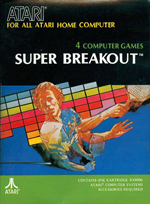 DP:
Do you still own
any of your games for these systems, either as a keepsake, or to show friends or
family?
DP:
Do you still own
any of your games for these systems, either as a keepsake, or to show friends or
family?
Larry Kaplan: I have a 7800 and all the 2600 games. I also have Stella on the PC with my game ROMS.
DP: Which of your titles are your favorite, and what types of games in general?
Larry Kaplan: My favorite games of all time are Everquest, Defender, Robotron, Medal of Honor, Dungeon Quest, Doom, Quake, and Dragon’s Lair. I guess the genre does not matter as much as great game play that doesn’t end.
DP: Looking back now, it's both amazing and unfortunate to see how (too much?) success derailed companies like Activision and Atari, or it so removed them from their "declaration of principles" of wanting to make fun games to wanting to make money. Even if the industry ‘crash’ didn’t come along, it seems some of these companies were destined to implode anyway, be it marketing mistakes, internal politics, or the loss of key employees. Even now, large game companies continue to undo themselves, from the inside-out. The recent lawsuits against Activision and EA reveal sweatshop-like work environments. And gamers are constantly lamenting over the lack of originality in most of today’s games. Can an idealistic company even exist in the marketplace now?
Larry Kaplan: Wow, long question and the answer should be even longer. But, the short answer is that the game industry evolved just like plays, movies, and television did: from independent creators to large teams, from shoestring budgets to massive budgets, and from idealistic companies to bureaucratic nightmares. There are the “indies”, and in the case of games it’s the web. There are thousands upon thousands of games out there, some of them quite good and compelling. Take a look at MU or Icy Tower and they, like many games and other software, are free.
DP: What are your thoughts on how the industry has evolved?
Larry Kaplan: It is unbelievable what can be done today in a game. The realism of the graphics and sounds are phenomenal. The action is intense and sometimes non-stop. The line between reality, movies and games is beginning to blur, and the future can only make games better and better. I can’t wait.
| GAMEOLOGY |
| GAME | SYSTEM | COMPANY | STATUS |
| Air-Sea Battle | Atari VCS/2600 | Atari | released |
| Bowling | Atari VCS/2600 | Atari | released |
| Combat (scoring system and last-minute bug fixes) | Atari VCS/2600 | Atari | released |
| Brain Games | Atari VCS/2600 | Atari | released |
| Street Racer | Atari VCS/2600 | Atari | released |
| Bridge | Atari VCS/2600 | Activision | released |
| Kaboom | Atari VCS/2600 | Activision | released |
| 400/800 OS | Atari 400/800 | Atari | released |
| Super Breakout | Atari 400/800 | Atari | released |
| Video Easel | Atari 400/800 | Atari | released |
| Army Men | PS2 | 3DO | released |
| "Doom-type game" | PS2 | 3DO | |
| "baseball game" | PS2 | 3DO | |
| "Tetris-like game" | not completed |